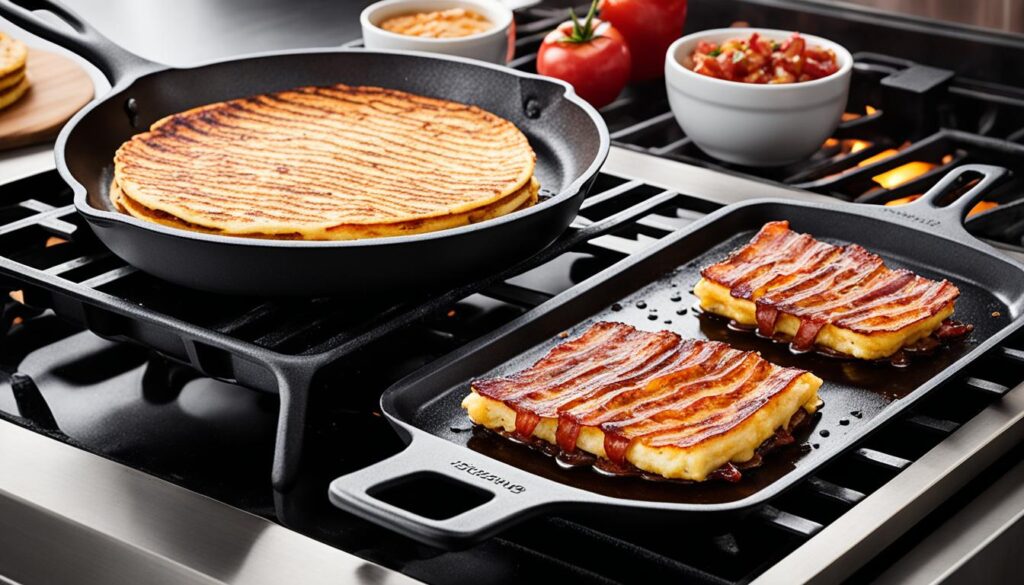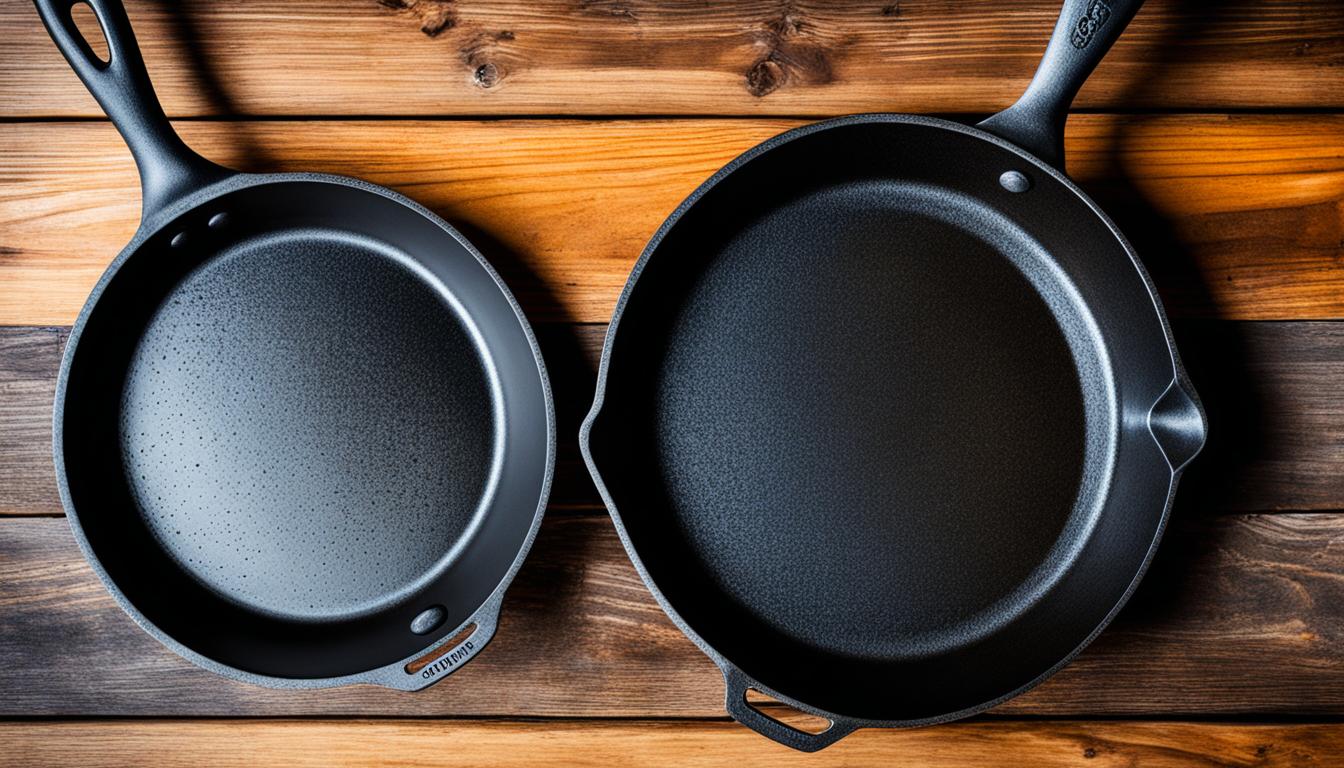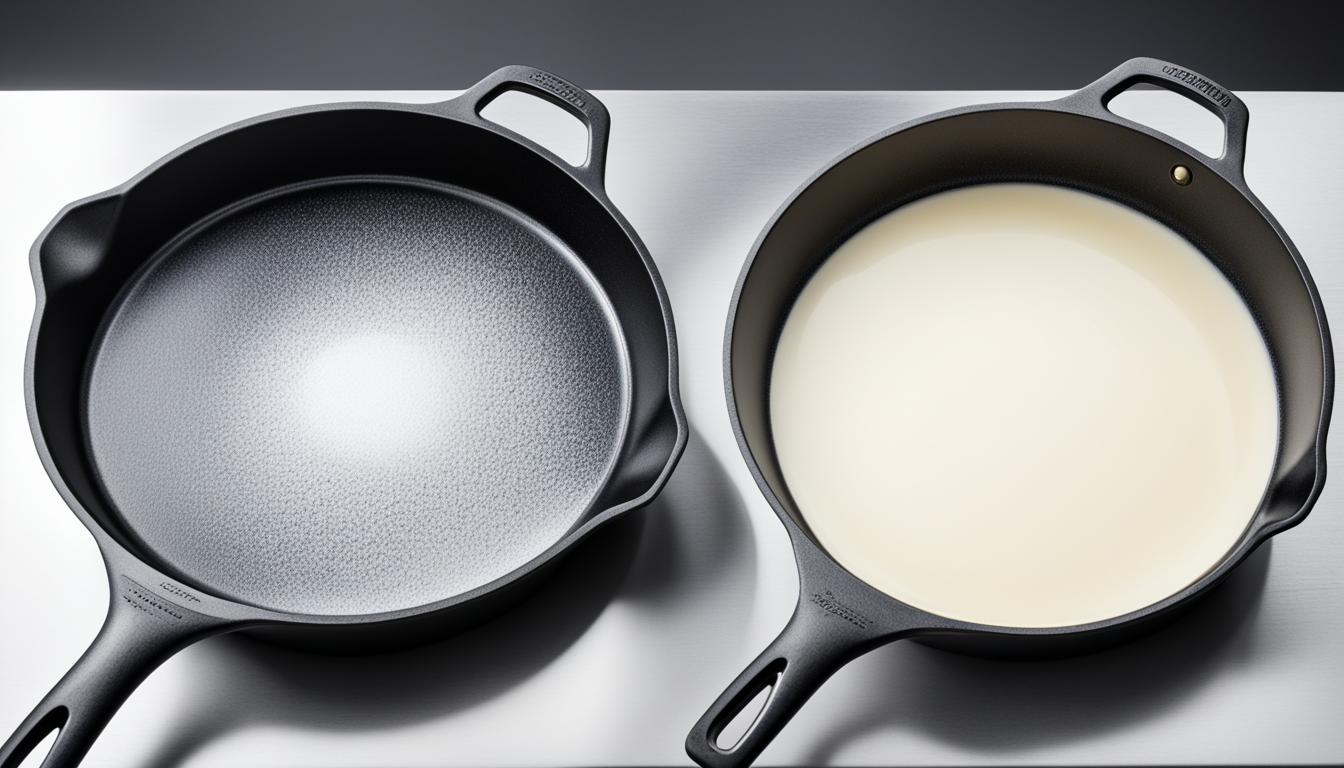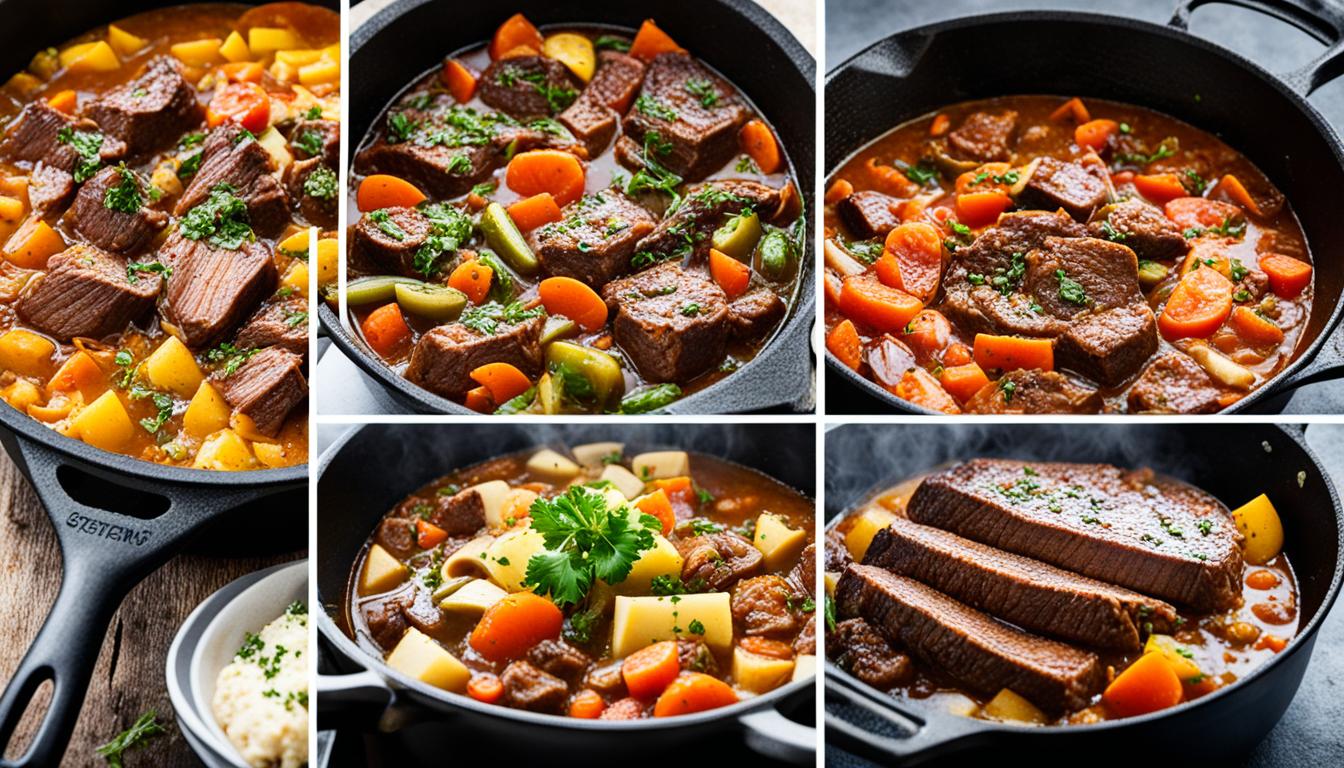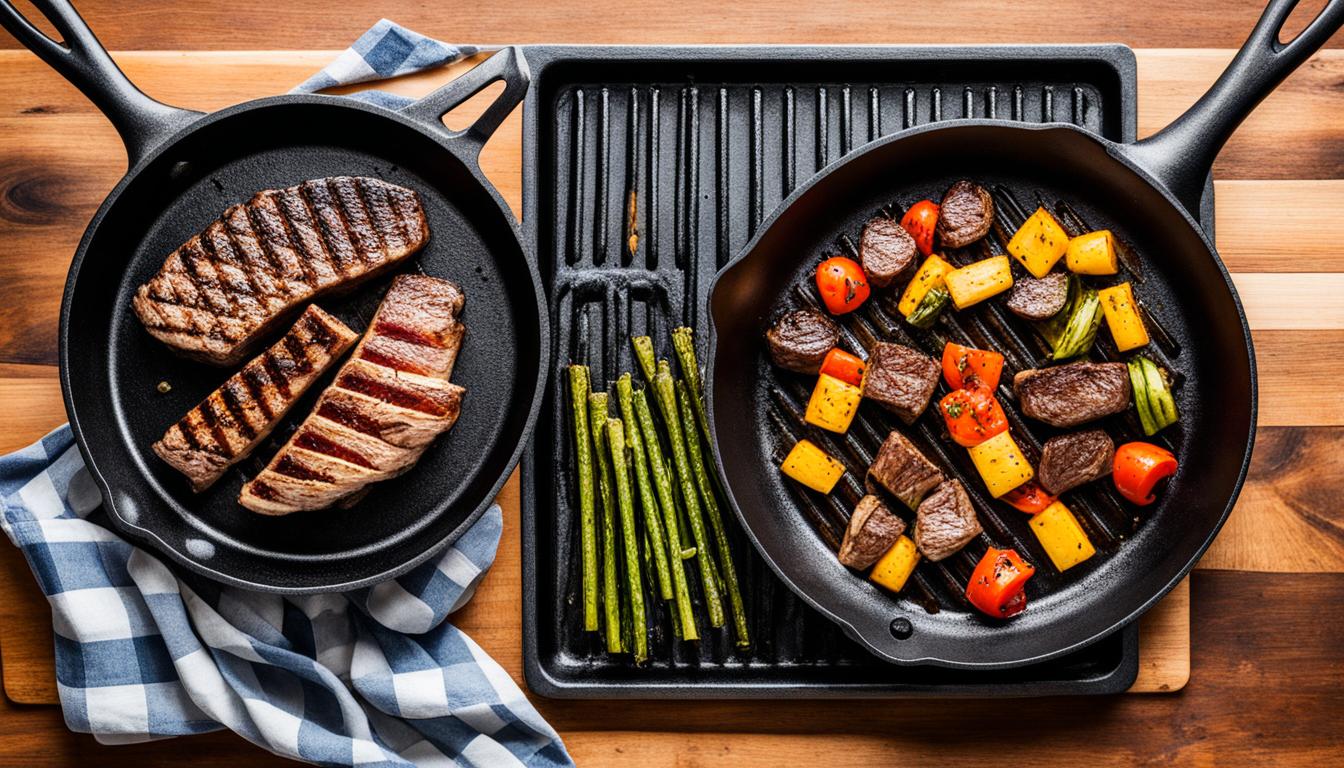Are you stuck between getting a cast iron skillet or a griddle? Choosing the right kitchen tool can be tough. As someone who loves to cook, I know the struggle. I want to help you figure out which would be better for you.
For years, cast iron has been a favorite in many kitchens. But griddles have something special too. The Oster DuraCeramic Electric Skillet, for example, is quick. It cooks 20% faster than normal skillets thanks to its ceramic coating. Alternatively, the GreenPan Elite Essential Smart Ceramic Electric 6QT Skillet has a large cooking surface. This makes it great for big family meals, measuring 17.25″ x 13.75″.
Imagine making pancakes on a sunny Sunday or grilling a delicious steak. Your choice of cookware matters a lot. We’re going to look at skillets and griddles to see which one fits your cooking style best.
Key Takeaways
- Cast iron skillets and griddles each have unique cooking advantages
- Skillets offer versatility for various cooking techniques
- Griddles excel at cooking large batches of food
- Both provide excellent heat retention properties
- The choice depends on your specific cooking needs and preferences
- Some electric skillets offer faster cooking times with ceramic coatings
- Cooking surface size varies greatly among different models
Table of Contents
- 1 Understanding Cast Iron Cookware
- 2 The Versatility of Cast Iron Skillets
- 3 Exploring Griddle Cooking
- 4 Heat Distribution and Retention
- 5 Seasoning and Maintenance
- 6 Cooking Surface Area Comparison
- 7 Versatility in Cooking Techniques
- 8 Durability and Longevity
- 9 Health Benefits of Cooking with Cast Iron
- 10 Outdoor Cooking and Camping Applications
- 11 Making the Final Decision: Skillet or Griddle?
Understanding Cast Iron Cookware
Cast iron cookware is a kitchen must-have, lasting through the years. It brings a sense of old times to my kitchen. It also performs amazingly well. We will look at what makes it stand out and the reasons behind its popularity.
What Makes Cast Iron Unique
Cast iron is different from other cookware due to its features. It keeps heat extremely well. This is great for browning meats or slowly cooking food evenly. The solid material spreads heat uniformly, avoiding cool spots that can ruin a dish.
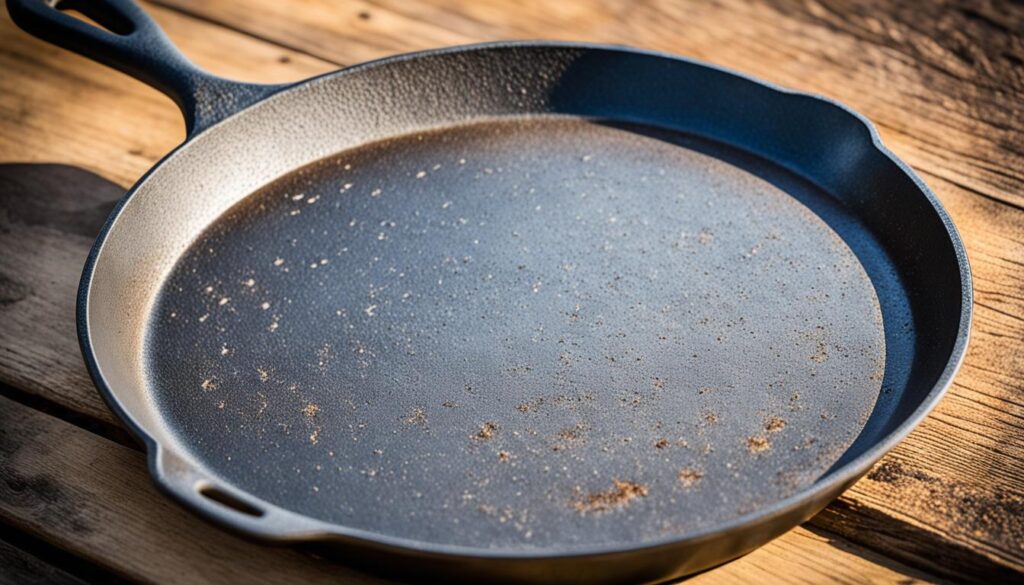
The History of Cast Iron in Kitchens
For centuries, cast iron has been a kitchen hero. It started in ancient China. But it won hearts in America during the 18th and 19th centuries. Then, pioneers used it for its tough nature and adaptability, keeping it in the family for years.
Benefits of Cooking with Cast Iron
Using cast iron in the kitchen has many pluses:
- It keeps heat well for consistent cooking
- The surface becomes non-stick with seasoning
- It boosts iron in your food
- Works on the stove, in the oven, and even over a fire
- With care, it can last a very long time
For me, properly seasoning a skillet is crucial. It protects and improves the surface, adding to its life and function. A well-maintained skillet can be an heirloom in your family, making it an excellent buy for your kitchen.
| Oil Type | Smoke Point (°F) | Price (32 oz) | Rating |
|---|---|---|---|
| Grapeseed | 400-420 | $12.99 | 4/5 |
| Avocado | 500-520 | $14.99 | 4.5/5 |
| Canola | 400-450 | $2.99 | 4/5 |
Choosing the right oil for seasoning is important. I go for oils with high smoke points like grapeseed or avocado. These oils form a strong seasoning that improves the skillet’s non-stick quality, making it cook better for longer.
The Versatility of Cast Iron Skillets
Cast iron skillets are like the Swiss Army knives of the kitchen. They can do so much, from stovetop cooking to oven-baking to grilling. These skillets handle high heat without an issue.
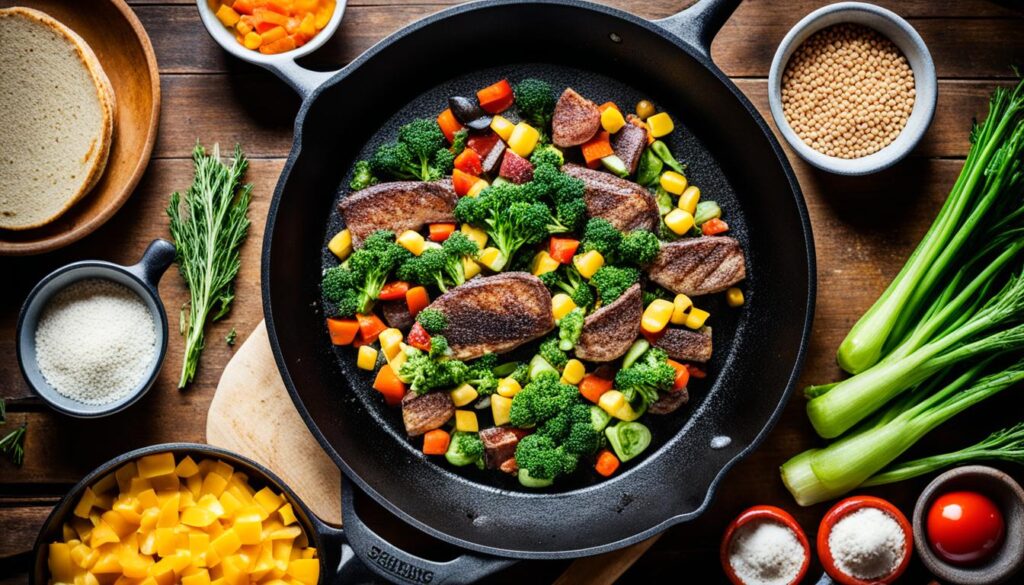
Baking a Chicago-style deep dish pizza is one way to see their flexibility. This recipe easily moves from stovetop sautéing to finishing in the oven. Here’s how to make it:
- Prepare the dough with 2 1/4 cups all-purpose flour and 1/4 cup cornmeal.
- Season your 10.5-inch cast iron skillet. This size comfortably serves 4-6 people.
- Layer 1 pound of shredded mozzarella cheese and 1/2 pound of Italian sausage.
- Top with 1 can (28 ounces) of crushed tomatoes.
- Bake at 425°F for 30-35 minutes.
The whole process will take under 5 hours, including dough rising time. It ends with a perfect deep dish pizza. The crust will be crispy, and the center, gooey.
But there’s more to these skillets than pizza. They excel at many cooking methods:
- Searing: High heat retention creates perfect crusts on steaks.
- Frying: Even heat distribution ensures crispy, golden results.
- Braising: The skillet’s ability to go from stovetop to oven is ideal for tender, flavorful meats.
- Baking: From cornbread to cobblers, cast iron produces beautifully browned baked goods.
The skillet’s design with higher, sloped sides helps keep in liquids and aids stirring. This design makes them stand out, truly a kitchen MVP.
| Cooking Technique | Skillet Advantage |
|---|---|
| Searing | High heat retention |
| Frying | Even heat distribution |
| Braising | Stovetop to oven versatility |
| Baking | Consistent browning |
A well-seasoned cast iron skillet becomes essential in a kitchen. It can tackle all kinds of cooking methods. This makes it perfect for everyone, from beginners to expert chefs.
Exploring Griddle Cooking
Griddle cooking is a fun and useful way to make food. It’s great for cooking breakfast and making lots of food at once. Let’s look deeper into griddles and see why they’re so popular in American homes.
Types of Griddles Available
Griddles come in many types, each serving different needs:
- Cast Iron Griddles: They retain heat well and last long
- Carbon Steel Griddles: Light and heat up fast
- Electric Griddles: Perfect for indoor cooking, with adjustable heat settings
Electric griddles, such as the Presto 06857 and Hamilton Beach Durathon, are very flexible. They have 1400-1500 watts of power and a cooking area of 15 x 9 to 16 x 12 inches. This makes them ideal for making meals for a group.
Advantages of Griddle Cooking
Using a griddle has changed how I cook. These are several reasons why it’s my favorite:
- It cooks evenly everywhere
- It’s big enough to cook many items at the same time
- You can control the temperature precisely
- It’s easy to turn over food because of the flat surface
Popular Griddle Recipes
Griddles are perfect for breakfast and making lots of food. I enjoy making these favorite recipes:
- Classic Pancake Stack: For a big family breakfast
- Griddled Bacon and Eggs: A simple and delicious breakfast
- Smashed Burgers: Crispy on the outside, juicy inside
- Grilled Cheese Sandwiches: Make several at once
One of my go-to meals is a Chinese chicken cabbage stir-fry. It’s great for dinner, serving 4 people. Each serving is only 211 calories and gives you 27.2g of protein. It needs 1 pound of chicken, 4 cups of cabbage, and a tasty sauce with soy, garlic, and ginger. Cabbage is healthy too, with fiber and vitamins.
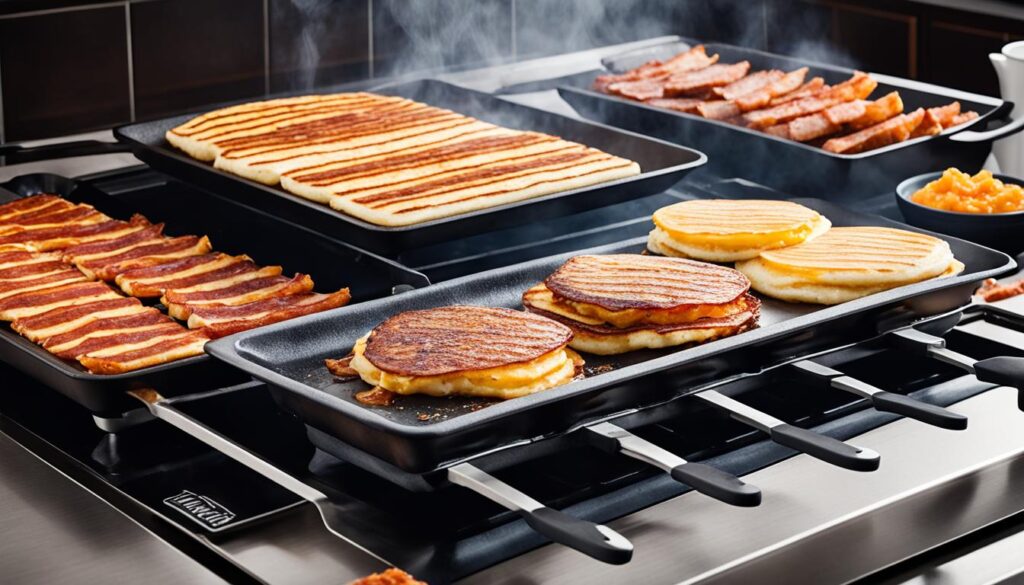
Griddle cooking is perfect for any occasion, like cooking for many or for a quick, everyday meal. It works well for breakfast and stir-fries. You can do so much with a griddle.
Heat Distribution and Retention
Exploring how different cookware handles heat is fascinating. Cast iron skillets and griddles shine in heat retention. Yet, they cook in different ways. We will look at their roles in temperature control.

Cast iron warms up slowly but keeps its heat well. It’s great for cooking steaks or making stews slowly. On the other hand, griddles, especially those made of carbon steel, react to changes in heat fast. This is perfect for cooking foods that require accurate temperature management.
For example, take a look at a favorite food—Shrimp and Broccoli Stir Fry. It shows how a cast iron skillet is beneficial:
- Total cooking time: 30 minutes (25 minutes prep)
- Serves: 4 people
- Calories per serving: 327
- Key ingredients: Shrimp (high protein, low calorie) and Broccoli (rich in fiber, vitamins C and K)
The cast iron skillet spreads heat well, resulting in a perfectly cooked meal in less than 30 minutes. Its even cooking highlights the shrimp and broccoli’s flavors.
Cast iron works best for dishes that need steady heat. Using it means you use less energy. While griddles are quicker to adjust their heat, they may need you to manage the temperature more often.
Knowing these details helps me pick the best cookware for my dishes. I choose a griddle for quick meals or fine sauces. For a great sear or slow cooking, my cast iron skillet is the best.
Seasoning and Maintenance
Seasoning is important for making a non-stick surface and keeping your cast iron cookware in top shape. I will show you how to season, clean, and restore your cookware.
How to Season Cast Iron Cookware
To season your cast iron, you’re creating a protective layer, keeping it rust-free and improving its non-stick features. It’s a straightforward process:
- Clean the cookware thoroughly
- Dry it completely
- Apply a thin layer of oil
- Bake it upside down at 450°F for one hour
- Let it cool in the oven
Repeat this 3-4 times for the best outcome. This method boosts the non-stick quality whether your cookware is new or old.
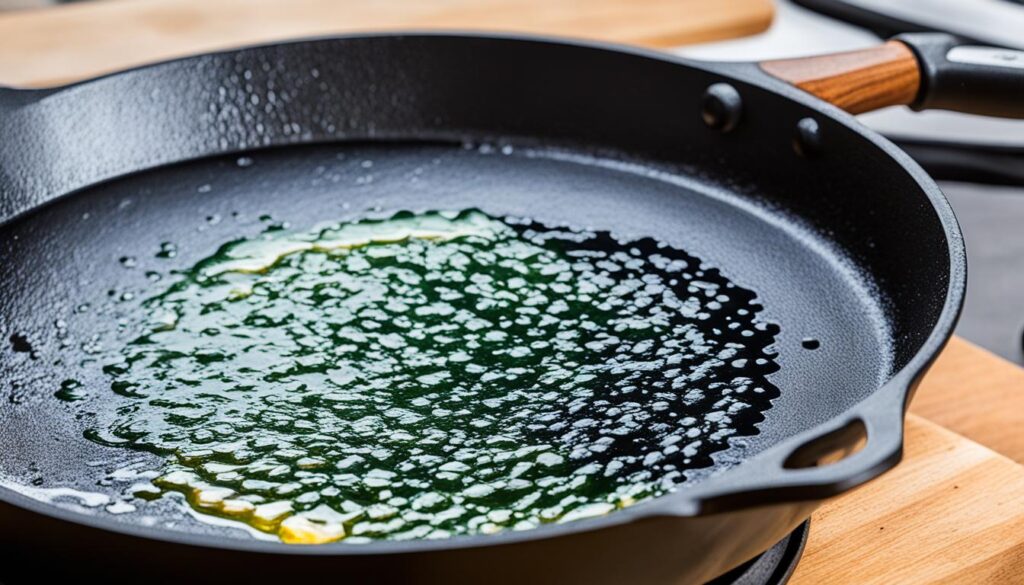
Cleaning and Care Tips
Looking after your cast iron is a must. I always do this after cooking:
- Rinse with hot water
- Scrub gently with a brush or salt if needed
- Dry thoroughly with a clean cloth
- Apply a thin layer of oil
Remember, don’t use soap or harsh cleaners as they harm the seasoning. For tough food bits, I use a water simmer and a gentle scrape.
Restoring Rusty Cast Iron
Don’t fret if your cast iron gets rusty, it can be fixed. Here’s how I handle rusty cast iron:
- Scrub the rust off with steel wool
- Wash with mild soap and water
- Dry completely
- Re-season following the steps above
By caring for it properly, your cast iron can be a family heirloom. I’ve restored old pieces using these methods. For more tips, try this shrimp and dumpling stir-fry recipe for a meal cooked in a well-seasoned skillet.
| Care Step | Frequency | Time Required |
|---|---|---|
| Seasoning | Every 3-6 months | 2-3 hours |
| Cleaning | After each use | 5-10 minutes |
| Rust Removal | As needed | 30-60 minutes |
Cooking Surface Area Comparison
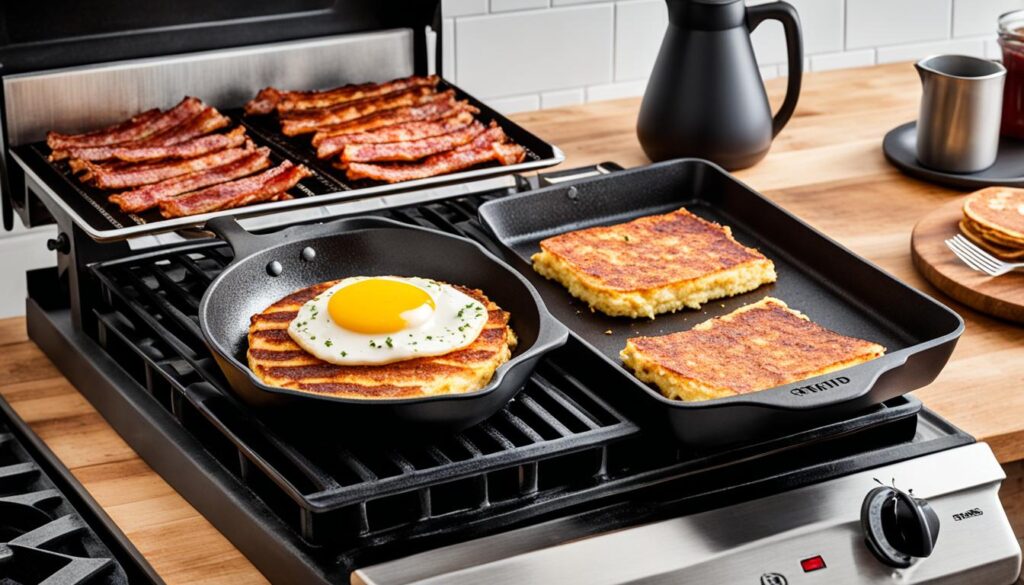
When you cook, it’s important to consider how much food you can make. The size of your skillet or griddle really matters. It can make cooking a joy or a challenge.
Cast iron skillets are great for small meals. They have a deep space for different cooking methods. A 10-inch skillet offers about 50 square inches of cooking area. This is perfect for searing or sauces.
Griddles, though, have much more space. They can cover two stove burners, giving you over 200 square inches to cook on. This big area is perfect for making lots of food at once.
| Cookware | Average Cooking Surface Area | Ideal Use |
|---|---|---|
| 10-inch Cast Iron Skillet | 50 square inches | Individual portions, small family meals |
| Standard Griddle | 200+ square inches | Large family meals, batch cooking |
Choosing between a skillet and a griddle is about what you love to cook. Think about making pancakes. A griddle can fit 8 at a time. Skillets are best for dishes that need space, like frittatas.
But, don’t forget about planchas. They are wider and can cook multiple dishes equally well. With different temperature zones, you can do a lot at the same time.
The right cookware size depends on your cooking habits. Whether it’s just for you or for many, knowing what fits your needs is key.
Versatility in Cooking Techniques
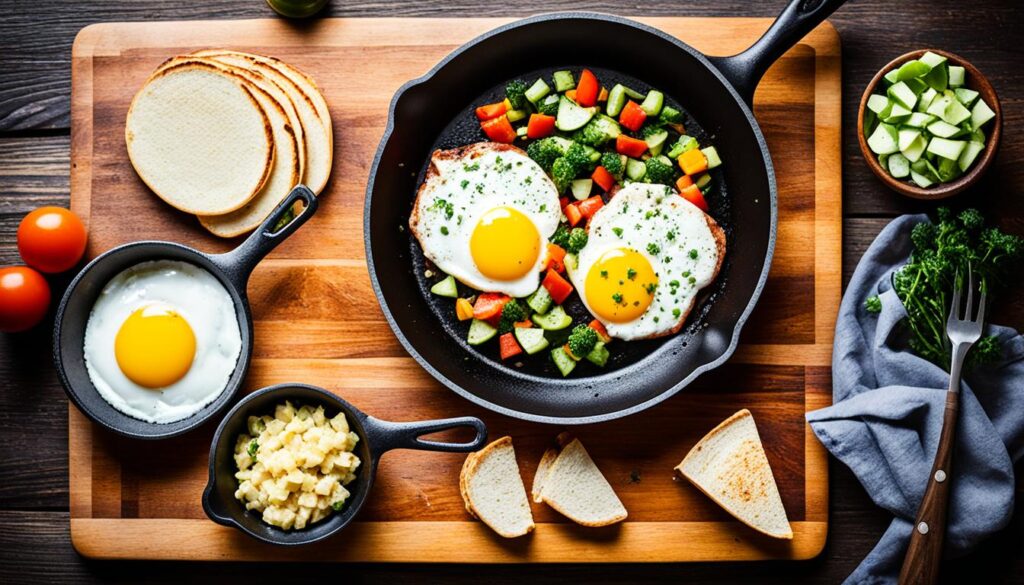
Exploring different ways to cook is a joy, with cast iron being a star. Skillets and griddles each have their own strong suits, adding flair to any dish.
Skillets are kings of dishes that need depth. From frying and braising to baking, they’re a must-have. Their high sides work well for slow cooking or a quick sear. Griddles, on the flip side, excel in cooking on a flat surface and handling large batches.
Skillets’ seamless move from stove to oven is a major win. This feature lets me begin a meal on the stove and finish in the oven. It broadens the range of meals I can prepare.
Griddles win with their space for cooking many items at once. They’re perfect for preparing several things, each at the right temperature, revolutionizing meal prep. Here’s how they compare in cooking:
| Cooking Technique | Skillet | Griddle |
|---|---|---|
| Frying | Excellent | Good |
| Searing | Good | Excellent |
| Baking | Good | Limited |
| Grilling | Limited | Excellent |
| Multi-item cooking | Limited | Excellent |
For breakfast fans, griddles are top-notch. They’re perfect for cakes, eggs, and bacon all at once. The even surface makes flipping easy, ensuring food stays intact.
Skillets are ideal for deep frying and stir-frying, thanks to their broader shape. Their sloped sides aid in mixing foods easily and capturing oil splashes. The cast iron supports even heating, crucial for frying.
Both skillet and griddle are game changers in the kitchen. Whether it’s searing steaks or grilling veggies, they unlock endless dishes. These tools have boosted my cooking game, widening my menu and honing my culinary skills.
Durability and Longevity
Cast iron cookware is known for lasting a long time. Skillets and griddles made from it can be in a kitchen for many generations. They often become family treasures. Let’s look at why cast iron is a smart buy for your kitchen.
Lifespan of Cast Iron Cookware
Cast iron cookware can last for a long time. A well-taken-care-of skillet can keep cooking for decades. This is because it’s built to last and can handle high heat without damage.
Here’s how long different types of cast iron can last with the right care:
- Traditional cast iron: Can last for generations with proper care
- Enameled cast iron: Typically lasts 3-5 years before showing signs of wear
- High-end enameled brands (like Le Creuset): Can last decades with careful use
Handling and Storage Considerations
Taking care of cast iron is key to making it a lasting kitchen tool. Always remember to:
- Clean the cookware with hot water and a non-scratch sponge
- Dry thoroughly to prevent rust
- Apply a thin layer of oil after each use
- Store in a dry place, avoiding stacking to prevent chipping
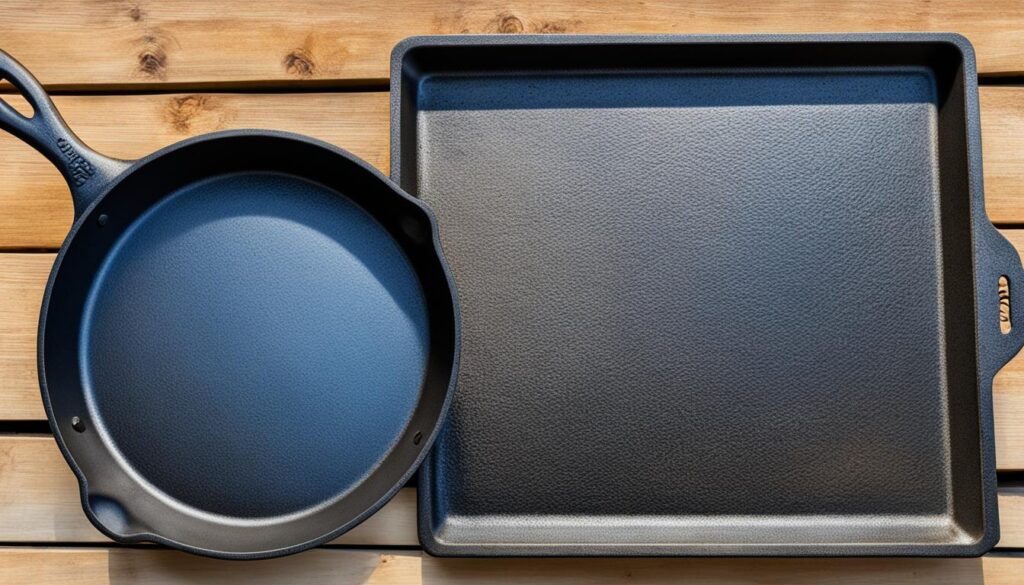
Investing in Quality Cast Iron
Buying quality cast iron is a smart decision for your kitchen. The cost can vary a lot, from $20 for a basic Lodge skillet to $250 for high-end options. The key is the durability they offer.
Even more affordable choices, like the Lodge Pre Seasoned Cast Iron Skillet at $20, can be top performers. For those looking at enameled cookware, consider brands like Le Creuset and Staub. They offer great quality but at a higher cost, around $200.
When you buy cast iron, you’re investing in more than a kitchen tool. It’s something that can add value to your cooking for many years. With the right care, these items can become family heirlooms.
Health Benefits of Cooking with Cast Iron
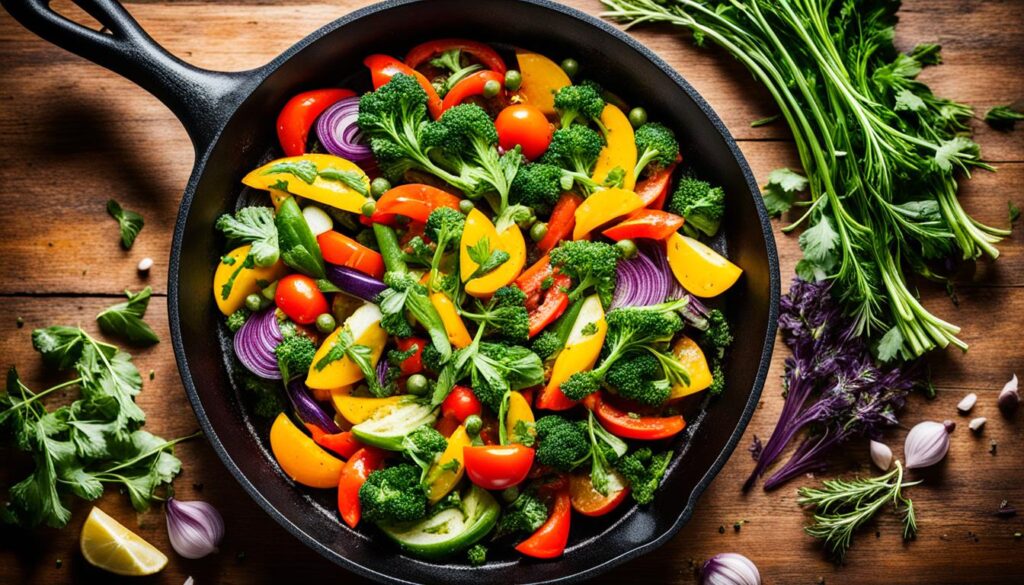
I love using cast iron for cooking. It’s a smart pick for those after non-toxic kitchen options. This is unlike non-stick pans, which might have chemicals. Cast iron is a safe choice for your meals.
Cast iron can boost the iron in your food. Cooking acidic stuff in it lets a bit of iron move to the food. This helps people who might need more iron.
Here’s why cooking with cast iron is good for you:
- Increased iron content in food
- Non-toxic cooking surface
- Reduced need for cooking oils
- Versatility in cooking methods
Studies show cast iron can really raise the iron content in meals. A research piece in the Journal of the American Dietetic Association found higher iron in food from a seasoned iron skillet.
I use my cast iron skillet a lot for cooking healthy meals. It lets me do so many things like sear meats and sauté veggies. Even baking cornbread is great in it. Since the pan gets seasoned naturally, I need less oil.
But, remember cast iron isn’t perfect for all kinds of dishes. Foods with lots of acid, such as tomato sauce, might work better in different pots. This is to keep the pan’s seasoning and your food taste good.
To sum it up, adding cast iron to your kitchen is a good move for your health. It’s safe, boosts iron in your meals, and is versatile. This helps you make your cooking healthier.
Outdoor Cooking and Camping Applications
I’m thrilled by campfire cooking and outdoor culinary adventures. Cast iron is key for these experiences. We’ll talk about using our kitchen gear outdoors.
Using Cast Iron Over Open Flames
Cast iron is tough, perfect for cooking over fires. Both skillets and griddles heat up well, great for camp meals. Let’s look at what cookware is best for outdoor cooking:
| Item | Price | Features |
|---|---|---|
| Weber Q1200 | $209.00 | Portable, perfect for small groups |
| Weber Q2200 | $269.00 | Big cooking area, ideal for families |
| Cabela’s Stainless Steel Tabletop Grill | $99.00 | Great price, small and easy to use |
| Blackstone 17″ Single Burner Griddle | Varies | Good for breakfast, and it’s easy to clean |
Portability Factors
Weight matters for portable kitchen gear. Let’s compare some cast iron skillets:
- Lodge Cast Iron Skillet (10-inch): 7 lbs 7.6 oz
- Barebones All in One (10-inch): 5 lbs 9.5 oz
- Camp Chef Cast Iron Skillet (10-inch): 4 lbs 14.1 oz
- GSI Guidecast Frying Pan (10-inch): 3 lbs 1.2 oz
The GSI Guidecast is the lightest, great for hiking. But, the Barebones All in One is heavy, yet spreads heat well.
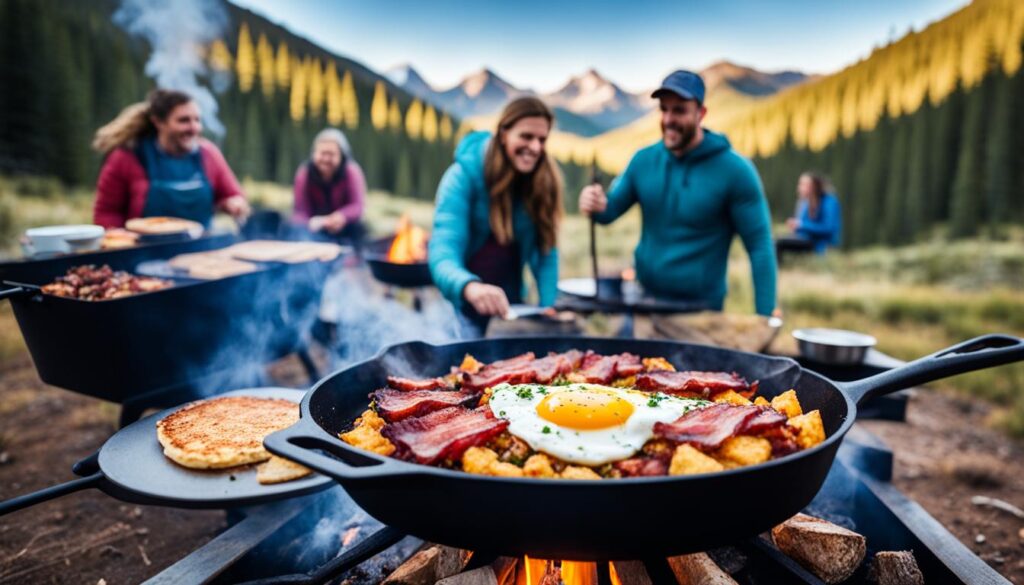
Recipes for the Great Outdoors
Let’s make a tasty campfire dish in our cast iron skillet: One-Pot Campfire Chili.
Ingredients (serves 4):
- 1 lb ground beef
- 1 can (15 oz) kidney beans, drained
- 1 can (14.5 oz) diced tomatoes
- 1 small onion, diced
- 2 cloves garlic, minced
- 2 tbsp chili powder
- 1 tsp cumin
- Salt and pepper to taste
Instructions:
- Heat your cast iron skillet over the fire.
- Cook the ground beef until brown, then drain.
- Sauté onions and garlic until soft.
- Next, add beans, tomatoes, and spices.
- Let it simmer for 20-30 minutes, stirring sometimes.
- Enjoy your tasty outdoor meal!
This recipe shows how good cast iron is for campfire cooking. The skillet keeps the chili hot, great for chilly nights outside.
Making the Final Decision: Skillet or Griddle?
Choosing between a cast iron skillet and a griddle depends on what you like to cook. They both are key items in the kitchen but have different uses. Skillets work well for small meals or ones that need to be deep. Use them for searing meat, making sauces, or baking cornbread.
On the other hand, griddles are perfect for cooking a lot at once. They are great for breakfast, letting you cook pancakes, eggs, and bacon together. Their flat surface also helps with cooking thin foods like fish or veggies. Plus, they’re handy for cooking many burgers or sandwiches for a crowd.
In my opinion, owning both of these is the best for cooking flexibility. A skillet is good for dishes that have liquids because of its high sides. A griddle’s flat space is great for foods that need room. If space or money is an issue, think about what you cook most often. Both are durable and can last a long time if you take care of them well.
